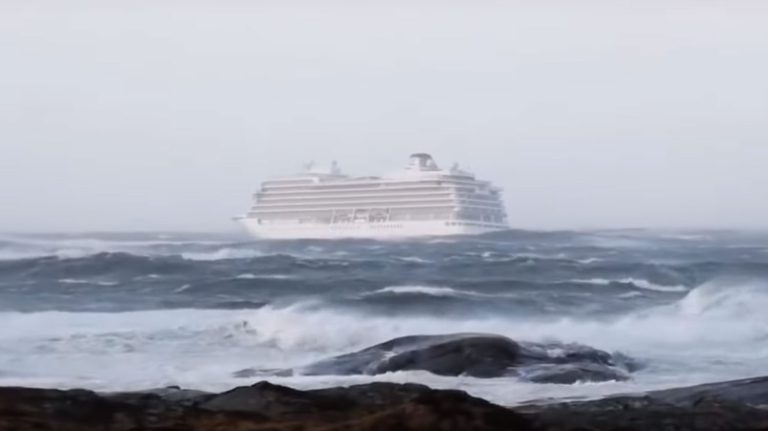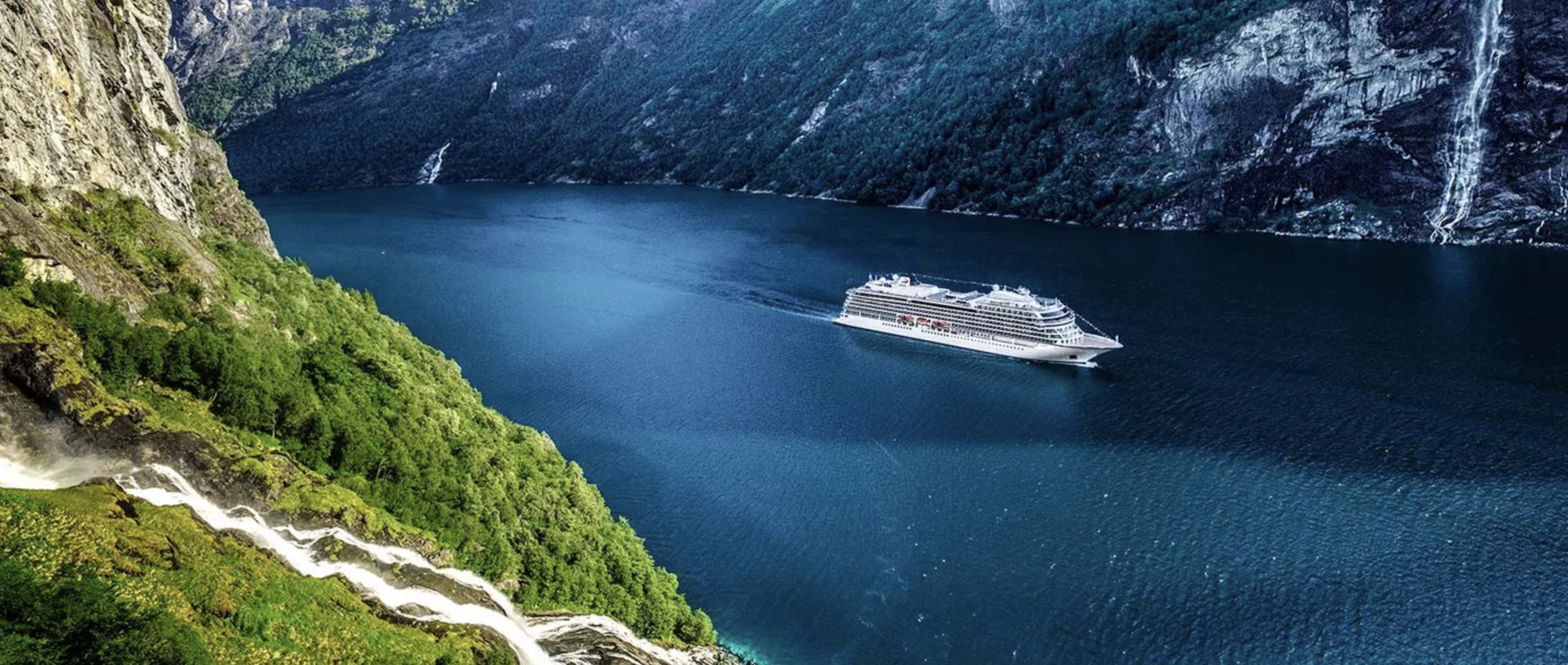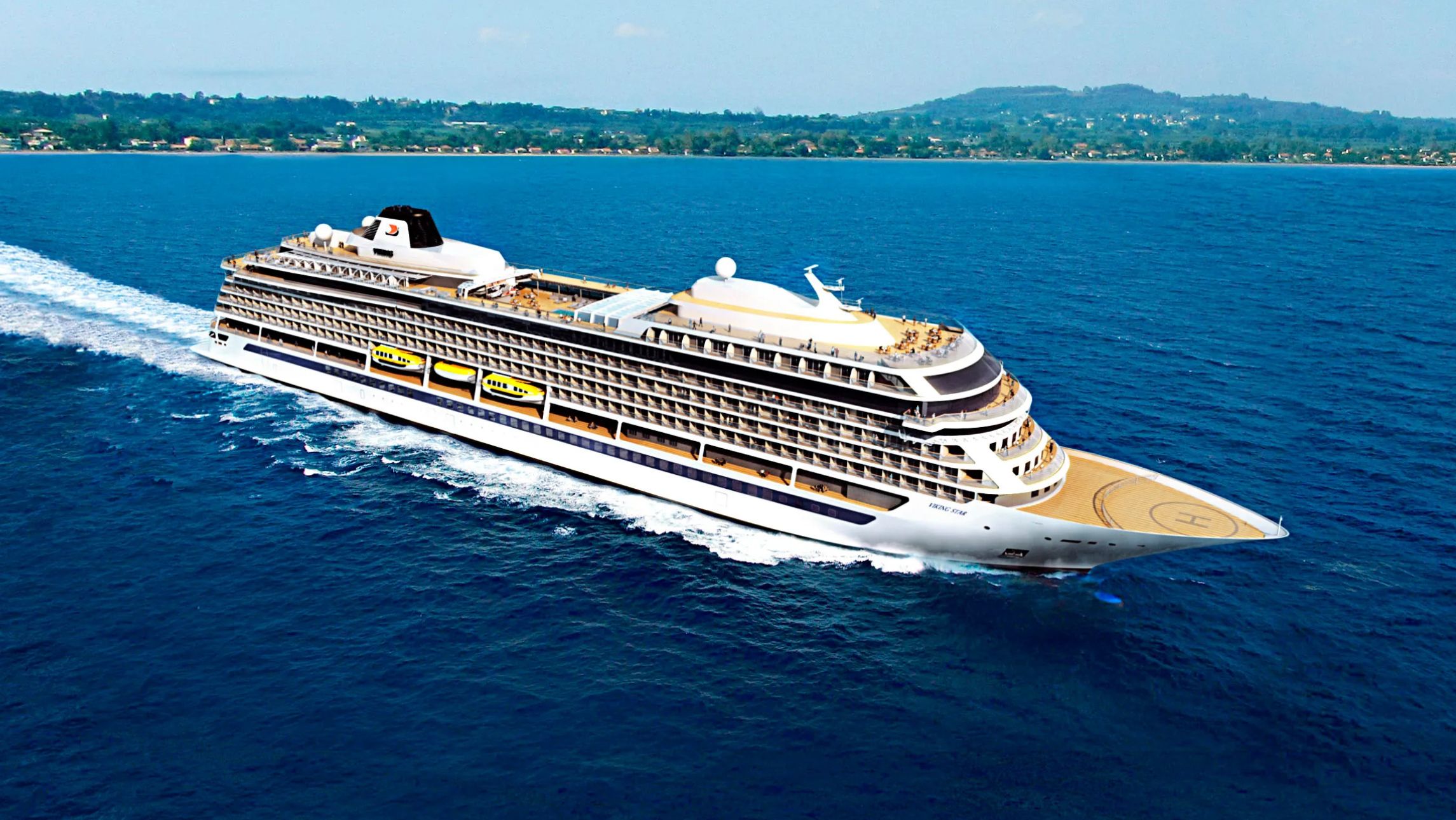Investigators from three countries are today continuing to piece together the weekend events that led up to the dramatic rescue of 1,300 passengers and crew from the Viking Sky, which was hit by huge storms in Norway and lost power in all four engines.
The helicopter evacuation of over 400 passengers, including some from Australia, sparked headlines around the world.
Two questions have emerged at the top of the investigators to do list:
- Find out why Finnish Captain Bengt-Owe Gustafsson and two Norwegian pilots put to sea when the huge storm that eventually engulfed the vessel was already on weather charts and had caused other ships to stay in port. This was the first itinerary along an Arctic Circle route, and a first for Viking in the region’s Winter season.
- How could all four engines lose power on a ship that is just 18 months old and built to the highest specifications.
In early unconfirmed reports of the investigators’ findings, Lars Alvestad, head of Norway’s maritime agency, said the engines had sensors to detect low lubricating oil levels. If they recorded low levels threatening to seize the engines, they automatically shut them down.
Mr Alvestad told reporters that the amount of lubricating oil was “within set limits, however relatively low” as the Viking Sky reached Hustadvika – a shallow stretch of coastline known for shipwrecks.
“The heavy seas in Hustadvika probably caused movements in the tanks so large that the supply to the lubricating oil pumps stopped,” said Mr Alvestad.
Viking Ocean Cruises said in a statement that it “welcomed the prompt and efficient investigation.”
The statement added: “We have inspected the levels on all our sister ships and are now revising our procedures to ensure that this issue could not be repeated.”
Dag S. Liseth of Norway’s Accident Investigations Board said “the high risk which the ship, its passengers and crew were exposed to made us decide to investigate the incident.”
Today, the ship remains in Norway. And passengers, filled with relief after a miraculous and daring escape, are heaping praise on a crew that remained calm and resolute throughout an ordeal that lasted more than 20 hours.
Viking Sky – How the story unfolded
The drama began last Saturday, when the Viking Sky sent out a May Day message. Her engines had stopped in the middle of a storm and hurricane winds.
The world watched transfixed as the deluxe vessel listed and rolled in heavy seas without power. Its 930 passengers, wearing orange lifejackets and some ankle deep in water from waves breaking over smashed windows, took to social media to record their plight in graphic images and audio.
The ship was just over 2 km from shore and some local fishermen expressed fears it could have run aground on nearby rocks had the crew not managed to start one engine and get an anchor down.
Videos showed heavy furniture skidding across the ship’s lounge, planks crashing from the ceiling.
Rescue craft had to turn back because of the high seas, and a cargo vessel which tried to help also ran into engine trouble.
Eventually, the Norwegian rescue authorities launched five helicopters in a daring rescue that plucked hundreds of passengers one-by-one from the deck of the ship.
A total of 479 were evacuated by helicopter during the 20-hour ordeal and taken to a rescue centre or hospital.
Below decks, the crew were battling to restart the engines and finally revived two. The decision was made to limp into port with tugs standing by, and suspend the risky helicopter rescue.
Twenty people suffered injuries – from cuts, bruises to broken bones and Viking’s chairman Torstein Hagen summed up the incident by saying: “We’ve been lucky.”
Speaking to news.com.au, Australia passenger Stephen Medcalf and his wife, Judith were on their first cruise.
“We were quite comfortable, but we heard reports of people falling out of bed because of the rougher conditions,” he said.
“On the Saturday morning, the weather really started to deteriorate. Chairs and pot plants were falling everywhere, and the swell started getting bigger and bigger.
“At 1.30pm, Judith and I went to lunch, and then at 2pm, the engines failed and lost power. That’s when the ship turned in to the swell and was rolling 45 degrees. There were chairs, glasses and wine bottles flying everywhere.”
The couple, who travelled from the Sunshine Coast said that they felt calm until the captain started making announcements.
“When the emergency signal was given and everyone had to put on their life jackets, the captain made another announcement that made me a little nervous,” he said.
“He came on the loudspeaker and called out a mayday, and put out emergency advice that he wanted to evacuate the whole ship.
“But the key words that worried me were when he said ‘close all water tight doors.’ That was a key indicator that we were in for big trouble. That made us feel a little tense.”
Passengers and crew were praised for handling the situation, there are still many unanswered questions into why this accident happened.
The storm that sparked the drama
While some maritime experts and meteorologists have criticised the line, captain and pilots for allowing the ship to sail, others have said if the engines had not failed, the ship would be equipped to handle the rough conditions.
Modern ships and meteorologists together usually mean vessels can avoid storms, though the seas around Norway are particularly treacherous.
The weather conditions that the ship encountered were extreme. One meteorologist pointed out that the storm had produced “a bomb cyclone” and “hurricane” force winds.
Captain Michael Lloyd, a former sea captain with five decades of experience, told the online publication, Quartzy that these conditions are not unusual for this part of the world during winter.
“That kind of weather is not unusual for where that ship was, especially in March, which is a windy month,” he said. He added that if the engine had not failed, things would have likely been fine onboard (if a bit rocky).
Captain Bengt-Owe Gustafsson was accompanied by two Norwegian pilots. According to local Norwegian newspaper, Bergens Tidende, Mr Gustaffson made the decision to sail at the recommendation of the pilots.
Pilot Master Emil Heggelund, however, told state broadcaster NRK on Monday that, “as far as I know, there was never a discussion (on the bridge of the vessel) over whether to sail.”
Another news outlet reported that Mr Heggelund claimed there was nothing to indicate that the modern ship Viking Sky would not be able to handle the rough conditions.
“We must remember that this is a 203-meter-long ocean-going vessel that’s only two years old and built to the highest standards,” he told NRK. “There was nothing to indicate that this ship couldn’t sail and carry out its voyage plan in a safe and secure manner.”
Adventure line, Hurtigurten, known for sailing around the Arctic and Antarctic region, said that their captains decided to delay departures.
“Because of the bad weather, our captain chose to delay departure from Bergen by 12 hours,” Hurtigruten spokesman Rune Thomas Ege told newspaper Dagens Næringsliv.
Why didn’t the Viking Sky use its lifeboats?
Some have asked why the crew aboard the ship didn’t lower the lifeboats to evacuate passengers. Viking Ocean has said: “The decision was taken for the safety of the passengers not to launch the lifeboats and to keep the passengers onboard and organize a precautionary evacuation by helicopter.”
Mr Lloyd told Quartzy that if the ship was in dire straits like if the anchor didn’t hold, of if it started to take on water, or was at risk of running aground, the lifeboats may have been deployed.
But the experienced captain said that deploying lifeboats in that kind of situation could be difficult.
“My concern [as a captain] would not be the lifeboats themselves, but the ability of [crew] to be able to lower them properly and get away from the ship in that kind of weather,” he said.
Keep calm and carry on – hero crew praised
With winds howling through broken windows and furniture gliding from one side of the room to another, one vivid image demonstrates the courage and calm professionalism of the crew aboard the Viking Sky: they just carried on serving.
While engineers battled below decks to restart the engines and the bridge monitored the daring helicopter rescue, the rest of the vessel’s crew were working with the passengers. Just another day at the office – and a tribute to their training.
Rich and Dina Janik from Iowa described the scene – but said there was no panic from either the crew or the passengers.
“People are soaking wet; glass is all over; and there is one guy with a broken leg,” Rich said. “Mind you, the ship is still rocking and rolling, but they move our group safely to a first-floor atrium area. No one panicked. Everyone – including the crew – did what they had to do “
Dina said: “The crew was great. We had our life jackets on and were wet, so they brought us blankets, towels; they brought us sandwiches, fruit, yogurt; and one young man even kept his sense of humour. He offered us un-salted water, saying he was sure we had plenty of saltwater. The crew never stopped checking on us.”
The Janiks noted the resolve of the passengers in their group. “No one let injury get in the way of helping each other,” Rich said. “No complaints. We were bumped and bruised, but we were OK.”
The crew tried to pass off “survival” bars as chocolate. The bars, with an oatmeal texture, had no taste and turned powdery, almost sawdust-like, when eaten.
“They tried to tell us it tasted like chocolate,” Rich said. “Not a chance … We made the restaurant manager bring us a big box of potato chips after that.”
Lara from Birmingham in the UK, said “the crew were magnificent and have kept the remaining passengers safe, warm and fed”.
The company position
Viking Cruises founder Torstein Hagen immediately flew to Norway to be at the scene once he heard of the ship’s plight, and was on shore to meet some passengers from the rescue helicopters.
Mr Hagen said: “They have had a shocking experience. Most of the passengers are senior citizens…imagine what it’s like to hang there on that wire. It must have been terrible – but they seem to have handled it well.”
Viking issued a statement around midday Saturday Sydney time:
“We can confirm that on March 23rd at 2pm (Norwegian time) the vessel Viking Sky, a 47,800 tonne ship travelling from Tromsø to Stavanger, carrying 915 guests and 458 crew, experienced a loss of engine power off the coast of Norway near Molde.
“We are working closely with the relevant authorities and all operational procedures were followed in line with international regulations. In addition Viking has dispatched an operational task force, including the company’s owner, to Molde.
“Our first priority was for the safety and wellbeing of our passengers and our crew, and in close cooperation with the Norwegian Coast Guard, the captain decided to evacuate all guests from the vessel by helicopter.
“The ship is proceeding on its own power and a tugboat is on site. The evacuation is proceeding with all necessary caution. A small number of non-life threatening injuries have been reported. Guests are being accommodated in local hotels when they arrive back on shore, and Viking will arrange for return flights for all guests.
“We are in the process of updating the website with the latest information and activating special telephone numbers for passengers and their relatives. If you have questions or concerns about any guests onboard, please visit:
https://www.vikingcruises.com.au/oceans/my-trip/current-sailings/index.htmlThe next sailing, Scandinavia & the Kiel Canal, which was scheduled to embark on March 27th has been cancelled, and guests and their travel agents have been informed.
So how safe is your cruise
Very. Cruise holidays continue to be one of the safest forms of vacation.
Here at Cruise Passenger we are amazed that, with 27 million cruisers world wide, there are so few incidents involving ships in trouble.
And Viking Cruises, relatively new to Ocean but with a proud decades-long history on rivers, has an enviable safety record.
Cruise Lines International Association Australasia says:
For Cruise Lines International Association (CLIA) and its Cruise Line Members, the safety of guests and crew is the highest priority and is fundamental to their operations. Even with an increase in cruise capacity, cruise lines have maintained an exceptional safety record – making cruising one of the safest ways to travel. In fact, cruise travel is safer than virtually every other form of travel.
A study by GP Wild analysing cruise ship operational incidents shows that while worldwide cruise ship capacity grew by more than 41.5 percent from 2009 to 2016, over that same six-year period the number of operational incidents has trended down with an average of 19.4 incidents per year, prioritising cruise lines’ safety record ahead of other modes of leisure transportation.
Ensuring Safety at Sea
- Crew member Training: Crew members receive robust training in safety, security and first aid to prevent and respond to potential emergency situations.
- Heavily Scrutiny: Cruise ships are among the most scrutinised vessels at sea. With oversight beginning at design and construction, the International Maritime Organisation (IMO), flag and port state authorities, and classification societies provide strict safety standards and oversight throughout a ship’s operations.
- Constant Improvement: CLIA and its Cruise Line Members constantly work to improve safety by reviewing operational procedures to improve safety processes and technology. With new polices implemented and continual meetings with an Independent Panel of Experts comprised of top maritime and transportation professions to provide advice on measures to enhance safety, the cruise industry is always looking to improve.
- Precautions: Every cruise ship must be equipped with enough survival craft, including life boats and life rafts, to accommodate at least 125 percent of the number of persons on board. In addition, all survival craft must be tested and meet rigorous international guidelines.
Cruise ships today are the safest that have ever sailed, thanks to the rules, regulations, and technological innovations that govern their design.









It would have been a dreadful experience ,from the sound of all reports the staff where top notch.
I believe if your times up it’s up.
I would definitely go on the cruise.
We travelled on Viking Sky on January 23 2019 on the exact route but in reverse. Your report is incorrect stating this cruise was the first itinerary along the arctic circle route and a first for Viking in the winter season. We were on the inaugural cruise (thankfully not this one) to the Northern Lights. We saw them too….brilliant.
Great report at has not put us off planning for another cruise.
Well done to all crew